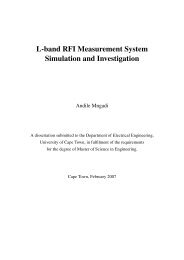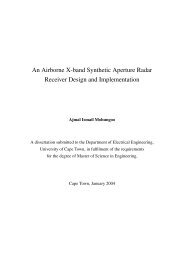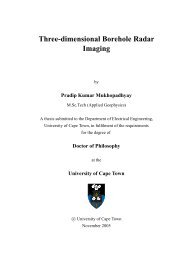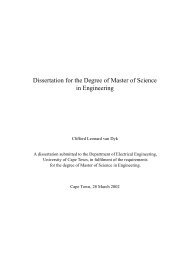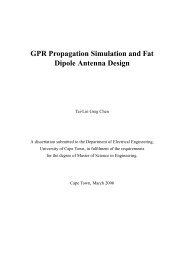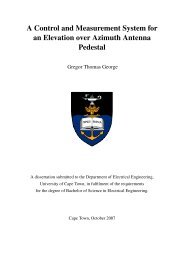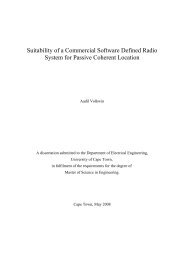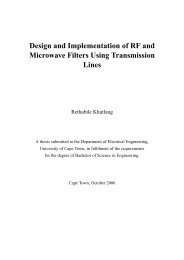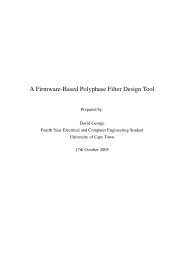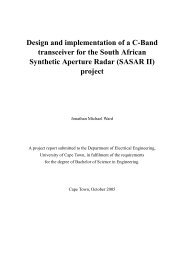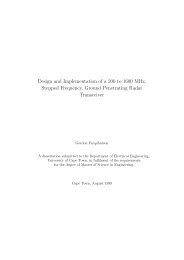Design and Implementation of a Pillbox Antenna for an Airborne ...
Design and Implementation of a Pillbox Antenna for an Airborne ...
Design and Implementation of a Pillbox Antenna for an Airborne ...
Create successful ePaper yourself
Turn your PDF publications into a flip-book with our unique Google optimized e-Paper software.
H−pl<strong>an</strong>e Power Patternsradiation intensity,dBi−5−10−15−20−25−30−35−40−45−50−55co−polcross−polmeasured ************4.1 degrees−3 dB−20 −15 −10 −5 0 5 10 15 20theta−d,degreesFigure 10: Measured E-pl<strong>an</strong>e pattern <strong><strong>an</strong>d</strong> cross-pol per<strong>for</strong>m<strong>an</strong>ce<strong>of</strong> <strong>Pillbox</strong> (W.r.t peak gain)Figure 11: Measured H-pl<strong>an</strong>e Pattern <strong><strong>an</strong>d</strong> Cross-polPer<strong>for</strong>m<strong>an</strong>ce <strong>of</strong> <strong>Pillbox</strong> (w.r.t. peak gain)beamwidth was measured <strong><strong>an</strong>d</strong> found to be 24 ± 0.5 ◦in comparison to the predicted value <strong>of</strong> 25 ◦ . The firstsidelobe level was found to be approximately -11 dBcompared to a predicted value <strong>of</strong> -13 dB. The <strong>an</strong>tenna<strong>of</strong>fers good cross-polarization rejection in the E-pl<strong>an</strong>e(levels less th<strong>an</strong> -30 dBm) within 20 ◦ <strong>of</strong> the beam peak.The peak cross-polarization level was limited to about-22 dBm relative to the peak <strong>of</strong> the main beam in theE-pl<strong>an</strong>e. The noise floor <strong>of</strong> the receiver was approximately-80 dBm (-60 dB relative to the peak <strong>of</strong> the mainbeam co-polarized level).3.3.2 H-pl<strong>an</strong>e PatternFigure 11 shows the measured H-pl<strong>an</strong>e pattern <strong><strong>an</strong>d</strong> thecross polarization per<strong>for</strong>m<strong>an</strong>ce. The first sidelobe levelwas found to be approximately -24 dB in comparison tothe MATLAB prediction <strong>of</strong> -23 dB. The measured H-pl<strong>an</strong>e 3 dB beamwidth was found to be 4.1 ◦ in comparisonto the predicted value <strong>of</strong> 3.8 ◦ . This is justified sincea wider beam implies lower sidelobes due to the taperimposed on the reflector edges. A maximum crosspolarizationlevel <strong>of</strong> -28 dBm occurred −3 ◦ <strong>of</strong>f the peak<strong>of</strong> the main beam. The cross-polarization rejection wasgenerally quite good within 20 ◦ <strong>of</strong> the beam peak (lessth<strong>an</strong> -30 dBm relative to the peak <strong>of</strong> the main beam).The noise floor <strong>of</strong> the receiver was approximately -77dBm (about 50 dB below the peak <strong>of</strong> the co-polarizedpattern).3.3.3 Power GainWe calculated the power gain using equation 21 whichis known as the Friis equation [2][8]:G t dBwhere( ) ( )4πR Pr= 20 log 10 + 10 logλ 10 −P tG r dB (21)G t dB = gain <strong>of</strong> tr<strong>an</strong>smitting <strong>an</strong>tenna [dB]G r dB = gain <strong>of</strong> receiving <strong>an</strong>tenna [dB]R =λ =<strong>an</strong>tenna separation [m]operating wavelength <strong>of</strong> <strong>an</strong>tenna [m]P r = received power [W]P t = tr<strong>an</strong>smitted power [W]We use the Friis equation <strong>for</strong> a far-field dist<strong>an</strong>ce <strong>of</strong> 20m with a tr<strong>an</strong>smit power equal to 20 dBm. We account<strong>for</strong> all the losses in the measurement system prior to <strong><strong>an</strong>d</strong>after taking measurements be<strong>for</strong>e calculating the powergain <strong>of</strong> the <strong>an</strong>tenna. The losses are shown in the lossbudget Table 1.The power gain was calculated to be 24 ± 0.5 dBicompared to a directivity <strong>of</strong> 25.6 dBi. Where the totaluncertainty is the sum <strong>of</strong> the uncertainties associatedwith G r <strong><strong>an</strong>d</strong> P r . The other qu<strong>an</strong>tities in equation21 above were measured accurately be<strong>for</strong>e <strong><strong>an</strong>d</strong> after theexperiments <strong><strong>an</strong>d</strong> they stayed the same.



